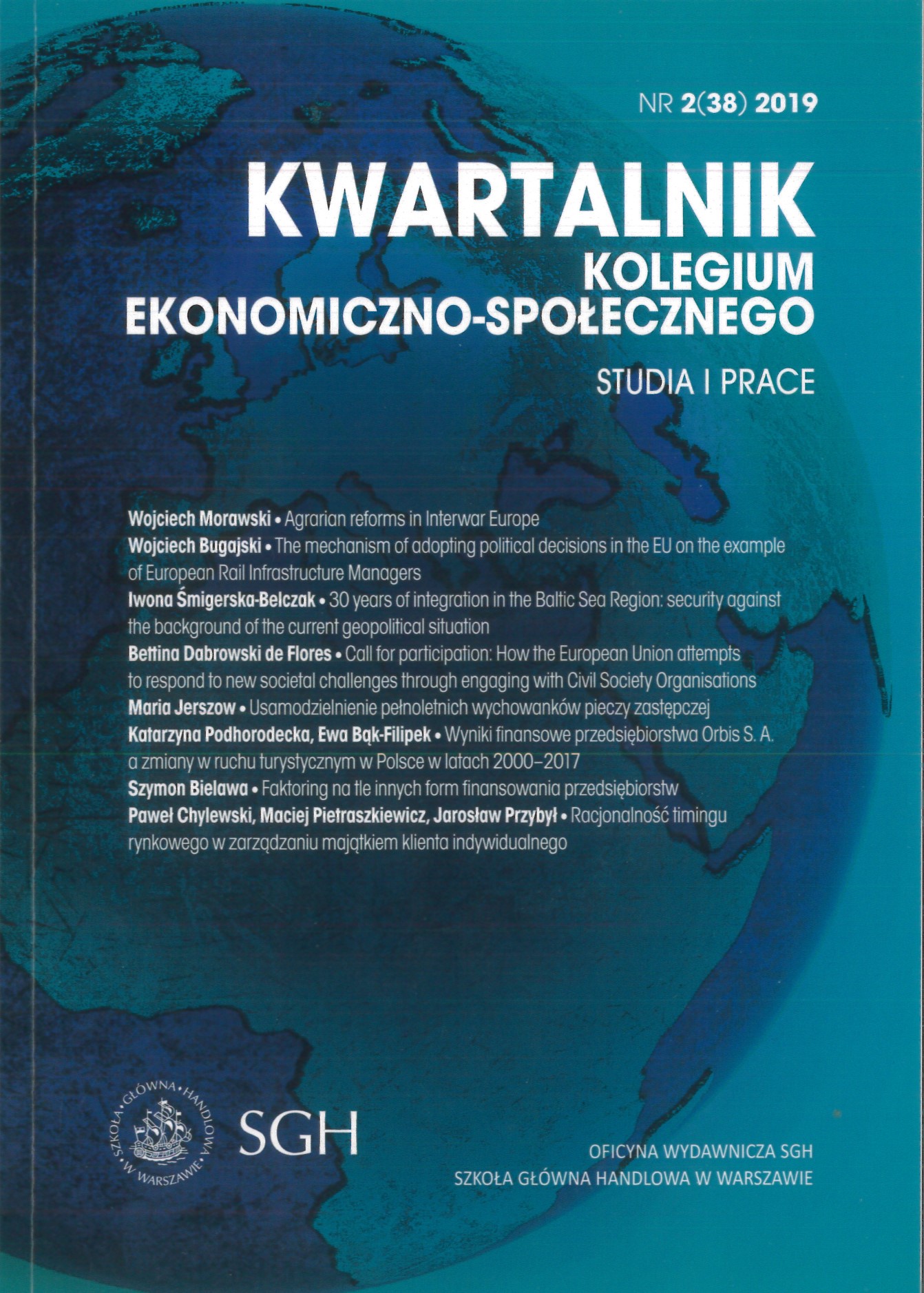Analysis of competition and concentration on the retail market in Poland based on the Linda index
Main Article Content
Abstract
The aim of this paper is to examine the level of competition in the industry bringing together the largest chains of retail stores with a food profile in Poland. Annul firm level data for the years 2005-2018 was used. We find that in the years 2011-2018, the oligopolistic arena consisted of 7 enterprises, which indicates a certain stabilisation of the number of the largest players on the market. On the one hand, the difference between the Linda index values and the level of "perfect equilibrium of forces" (PE) is increasing, which proves the growing market power of the largest players, also confirmed by the growing values of the CR7 and HHI concentration index. On the other hand, the empirical analysis showed an increase in the effectiveness of the main players in the analysed period. Furthermore, this paper confirms the effective market structure hypothesis (ESH) in the industry that brings together the largest grocery store chains in Poland.(original abstract)
Downloads
Article Details
Autor (Autorzy) artykułu oświadcza, że przesłane opracowanie nie narusza praw autorskich osób trzecich. Wyraża zgodę na poddanie artykułu procedurze recenzji oraz dokonanie zmian redakcyjnych. Przenosi nieodpłatnie na Oficynę Wydawniczą SGH autorskie prawa majątkowe do utworu na polach eksploatacji wymienionych w art. 50 Ustawy z dnia 4 lutego 1994 r. o prawie autorskim i prawach pokrewnych – pod warunkiem, że praca została zaakceptowana do publikacji i opublikowana.
Oficyna Wydawnicza SGH posiada autorskie prawa majątkowe do wszystkich treści czasopisma. Zamieszczenie tekstu artykuły w repozytorium, na stronie domowej autora lub na innej stronie jest dozwolone o ile nie wiąże się z pozyskiwaniem korzyści majątkowych, a tekst wyposażony będzie w informacje źródłowe (w tym również tytuł, rok, numer i adres internetowy czasopisma).
Osoby zainteresowane komercyjnym wykorzystaniem zawartości czasopisma proszone są o kontakt z Redakcją.
References
2. Bain, J. S., (1951). Relation of profit rate to industry concentration: American manufac-turing 1936-40, Quarterly Journal of Economics, 65, s. 293-324.
3. Baumol, W. (1982). Constable markets: An uprising in the theory of industry struc-ture, American Economic Review, 72, s. 1-15.
4. Begović, B., Mijatović, B., Paunović, M., Sepi, R., Hiber, D. (2002). Competition Policy in FR Yugoslavia - Existing Market Structures and Competition Institutions. Belgrade: Center for Liberal democratic Studies.
5. Bikker, J. A., Spierdijk, L. (2017). Handbook of cometion in banking nad finance, DNB Working Paper, Edward Elgar Publishing Limited.
6. Bukvic, R. (2017). Concentration and Competition in Serbian Banking Sector, The Scientific Journal of Cahul State University Bogdan Petriceicu Hasdeu: Economic and Engineering Studies, 2, s. 4-12. ssrn.com/abstract=3141748.
7. Bukvic, R., Pavlovic, R., Gajic, А. (2014). Possibilities of Application of the Index Con-centration of Linda in Small Economy: Example of Serbian Food Industries, Annals of the Oradea University. Fascicle of Management and Technological Engineering, 23 (13), 3, s. 159-164.ssrn.com/abstract=2728470.
8. Chen Chou, T.(1986). Concentration, Profitability and Trade in a Simultaneous Equation Analysis: The Case of Taiwan, The Journal of Industrial Economics, 34, 4, s. 429-443.
9. Demsetz, H. (1973). Industry structure, market Rivalry, and Public Policy, Journal of Law and Economics, 16.1, s. 1-9.
10. Feeny, S. (2000). Determinants of Profitability: An Empirical Investigation Using Australian Tax Entities, Working Paper No. 1, Melbourne Institute of Applied Economic and Social Research, The University of Melbourne.
11. Feeny, S., Rogers, M. (1999). Market Share: Concentration and Diversification in Firm Profitability. Melbourne Institute of Applied Economic and Social Research, Melbourne Institute Working Paper No. 20, The University of Melbourne.
12. Hicks, J. (1935), The Theory of Monopoly, Econometrica, 3, s. 1-20.
13. Jacquemin, A., de Ghellinck, E., Huveneers, C. (1980). Concentration and Profitability in a Small Open Economy, The Journal of Industrial Economics, 29, 2, s. 131-144.
14. Jeong, K-Y., Masson, R. T. (1990). Market Structure, Entry, and Performance in Korea, The Review of Economics and Statistics, 72, 3, s. 455-462.
15. Kuzmin, E. A., Volkova, E., Fomina, A. V. (2019). Research on the Concentration of Companies in the Electric Power Market of Russia, International Journal of Energy Economics and Policy, 9 (1), s. 130-136.
16. Leigh, A., Triggs, A. (2016). Markets, Monopolies and Moguls: The Relationship between Inequality and Competition, Australian Economic Review, 49 (4), s. 389-412. DOI:10.1111/1467-8462.12185. WOS:000392658800001.
17. Leuvensteijn, M., Bikker, J. A., Rixtel, A., Sørensen, C. K. (2007). A new Approach to measuring competition in the loan markets of the euro area, EBC Working Paper Series, 768, June, 3-5.18.
18. Linda, R., (1976). Methodology of concentration analysis applied to the study of industries and markets. Brussels: Commission of the European Communities.
19. Łyszkiewicz, W. (2002). Industrial Organization, Organizacja Rynku i Konkurencja. Warszawa: Dom Wydawniczy Elipsa." />
20. Martin, S. (1989). Industrial Economics, Economic Analysis and Public Policy. New York: Macmillan Publishing Company, London: Collier Macmillan Publishers.
21. Maryanchyk, I. (2006). Market Structure and Profitability in a transition Economy Ukrainian Case, Economic Education and Research Consortium Working Paper Series, Working Paper No. 03/06.
22. Pawłowska, M. (2014). Konkurencja w sektorze bankowym. Teoria i wyniki empiryczne. Warszawa: C. H. Beck.
23. Smirlock, M. (1985). Relationship between concentration and profitability in banking, Journal of Money, Credit and Banking, 17 (1), s. 69-83.
